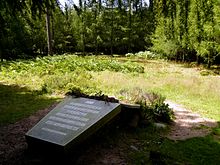Air Inter Flight 148
 The aircraft involved in the accident at Charles de Gaulle Airport, 6 January 1991 | |
| Accident | |
|---|---|
| Date | 20 January 1992 |
| Summary | Autopilot design flaw, wind gust, controlled flight into terrain |
| Site | Barr, near Strasbourg Airport, Strasbourg, France[1] 48°25′38.5″N 007°24′18.5″E / 48.427361°N 7.405139°E |
| Aircraft | |
| Aircraft type | Airbus A320-111 |
| Operator | Air Inter |
| Registration | F-GGED |
| Flight origin | Lyon Satolas Airport |
| Destination | Strasbourg Airport |
| Passengers | 90 |
| Crew | 6 |
| Fatalities | 87 (82 passengers, 5 crew members) |
| Injuries | 9 (5 serious, 4 minor) |
| Survivors | 9 (8 passengers, 1 crew member) |
Air Inter Flight 148 was a scheduled airline flight on 20 January 1992 that crashed in the Vosges Mountains, near Mont Sainte-Odile, while circling to land at Strasbourg Airport. Of 96 people on board, nine survived.[1]
Accident
Flight 148, commanded by Captain Christian Hecquet and First Officer Joël Cherubin,[2] departed Satolas Airport in Lyon, France. While being vectored for a VOR/DME approach to runway 05 at Strasbourg, it crashed at 19:20:33 CET in the mountains at an altitude of 2,620 feet (800 m).[1]
The pilots had no warning of the imminent impact because Air Inter had not equipped its aircraft with a ground proximity warning system (GPWS). It is speculated that this was because Air Inter – facing ferocious competition from France's TGV high-speed trains – may have encouraged its pilots to fly fast at low level (up to 350 knots below 10,000 feet, while other airlines generally do not exceed 250 knots), and GPWS systems gave too many nuisance warnings.[3][citation needed]
The accident occurred at night, under low cloud and with light snow.
Flight 148 was the third in a series of crashes caused, at least in part, by what was believed to be pilots' unfamiliarity with the sophisticated computer system of the Airbus A320. The Bureau d'Enquêtes et d'Analyses pour la Sécurité de l'Aviation Civile (BEA) believe that Flight 148 crashed because the pilots inadvertently left the autopilot set in Vertical Speed mode (instead of Flight Path Angle mode) then entered "33" for "3.3° descent angle", which for the autopilot meant a descent rate of 3,300 feet (1,000 m) per minute.[1]
Accident investigators determined that there was no single cause of the accident, but rather multiple factors that contributed to the crash. On the approach to the airport Air Traffic Control incorrectly warned the crew that they were to the "right" of the runway, causing the flight crew to experience high workload. When investigators input the descent rate, which had been set into a flight simulator, the aircraft initially did not crash. Further investigation revealed, however, that when a small amount of turbulence was introduced, a safety feature of the autopilot further increased the descent rate, adding to the chain of events that led to the crash.[3][citation needed]
Aftermath

Accident investigators recommended 35 changes in their report. Airbus modified the interface of the autopilot so that a vertical speed setting would be displayed as a four-digit number, preventing confusion with the Flight Path Angle mode.[4][5] The flight data recorder was upgraded so that it was able to withstand higher temperatures and for longer.[3][citation needed] The report also recommended that pilot training for the A320 should be enhanced.
Dramatisation
The story of the disaster was featured on the ninth season of Cineflix television show Mayday in the episode entitled "The Final Blow" (also known as Air Crash Investigation as episode entitled "Crashed and Missing" or "Doomed to Fail" (S09E07)).[3]
See also
- Jean-Pierre Lecocq, a victim of the disaster
- Air France Flight 296
- Indian Airlines Flight 605
- Airblue Flight 202
- American Airlines Flight 965
- Germanwings Flight 9525
- Crossair Flight 3597, a similar CFIT crash caused by violating Minimum Safe Altitude
- Prinair Flight 277
References
- ^ a b c d "Rapport de la commission d'enquête sur l'accident survenu le 20 janvier 1992 près du Mont Sainte-Odile (Bas Rhin) à l'Airbus A 320 immatriculé F-GGED exploité par la compagnie Air Inter" (in French). Bureau d'Enquêtes et d'Analyses pour la Sécurité de l'Aviation Civile. Archived from the original on 14 August 2012. Retrieved 14 April 2010.
{{cite web}}: Italic or bold markup not allowed in:|publisher=(help); Unknown parameter|deadurl=ignored (|url-status=suggested) (help) - ^ "Quatorze ans après, les causes de la catastrophe du mont Sainte-Odile restent incertaines" (in French). Le Monde. 2 May 2006. Retrieved 14 April 2010.
{{cite web}}: Italic or bold markup not allowed in:|publisher=(help) - ^ a b c d "The Final Blow," Mayday
- ^ [1] Archived 21 May 2012 at the Wayback Machine
- ^ "DSpace@MIT: Experimental Study of Vertical Flight Path Mode Awareness". Dspace.mit.edu. Retrieved 8 February 2014.
External links
- Accident description at the Aviation Safety Network
- Template:Fr icon "RAPPORT de la commission d'enquête sur l'accident survenu le 20 janvier 1992 près du Mont Sainte-Odile (Bas Rhin) à l'Airbus A 320 immatriculé F-GGED exploité par la compagnie Air Inter." – Bureau d'Enquêtes et d'Analyses pour la Sécurité de l'Aviation Civile (Archive)
- Template:Fr icon Text version of final report at the University of Bielefeld
Further reading
- Turner, Aimée. "Air France CEO Jean-Cyril Spinetta defends rejection of GPWS equipment on Air Inter A320 fleet, despite fatal 1992 St Odile mountainside crash." Flight International. 31 October 2006.
- Wastnage, Justin. "Video: January 1992 Air Inter Mt Saint Odile crash manslaughter verdict expected 7 November in Colmar." Flight International. 25 October 2006.
- Airliner accidents and incidents caused by pilot error
- Airliner accidents and incidents involving controlled flight into terrain
- Aviation accidents and incidents in France
- Accidents and incidents involving the Airbus A320
- Aviation accidents and incidents in 1992
- Airliner accidents and incidents caused by design or manufacturing errors
- Air Inter accidents and incidents
